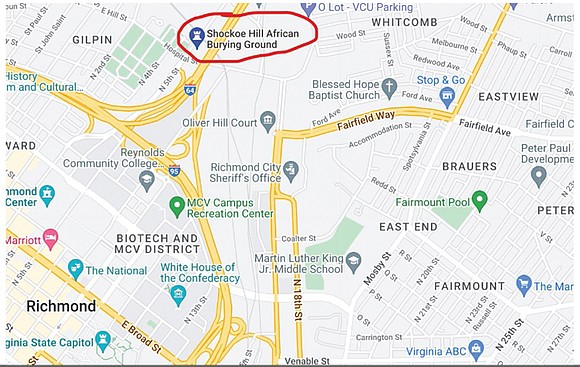Sacred burial site to be marked by mural
Jeremy M. Lazarus | 6/22/2023, 6 p.m.
A mural with a message embedded in large red, black and green stripes will soon mark an historic but largely unknown Black cemetery in North Side.
The mural is to cover an abandoned gas station that sits on top of graves in the Shockoe Hill African Burying Ground at 1305 N. 5th St., replacing the ugly graffiti that now mars the building while also calling attention to the sacred site.
The Richmond Planning Commission on Tuesday cleared the way for the city to repaint the building and embed the fol- lowing words in the stripes on the front and back sides of the building:
“Beneath this old gas station, that billboard and I-95/64 is Shockoe Hill African Burying Ground Active 1816-1879.”
The first line is to be in the red stripe; the second line is to be in the black stripe; and the third line is to be in the green stripe.
The goal is to compete with a highway billboard that also is on the burial site.
Burt Pinnock, the principal architect for Richmond-based Baskervill, came up with the design as a way to replace the gas station eyesore with a prominent identifier for the burial ground where up to 22,000 enslaved and free Black people were interred over the 63 years the cemetery was open.
Two people who are now the most active in protecting the cemetery, Lenora McQueen and former City Councilwoman Kimberly B. “Kim” Gray, started the process.
“We just wanted to paint the building,” Ms. Gray said. “We had a store willing to donate 10 cans of gray paint, and we were ready to go.”
Mr. Pinnock, whom the city has hired to lead a team to consider how best to memorialize the portion of the cemetery the city has repurchased, then proposed the mural as an alternative.
“Most people are still not aware that the cemetery is there,” he said.
The proposal went to the Planning Commission in May.
At the request of 6th District Councilwoman Ellen F. Robertson, the commission held off acting until the design could be presented and approved by the community at a June 15 meeting, the staff of the Planning Commission reported.
Before it was closed 144 years ago, the Shockoe Hill African Burying Ground was the largest publicly owned and operated cemetery for Black people in the country, according Ms. McQueen’s research.
But after it closed, the City Hall allowed city streets, railroad tracks and the highway to be run through it and sold off a portion for the service station that was built on top of it.
Ms. McQueen, a Texas resident who has relatives buried in the cemetery, is credited with getting city officials involved to save the burial ground that once covered 33 acres and with help from Ms. Robertson, getting the city to repurchase the acre of land where the gas station stands in 2021.








